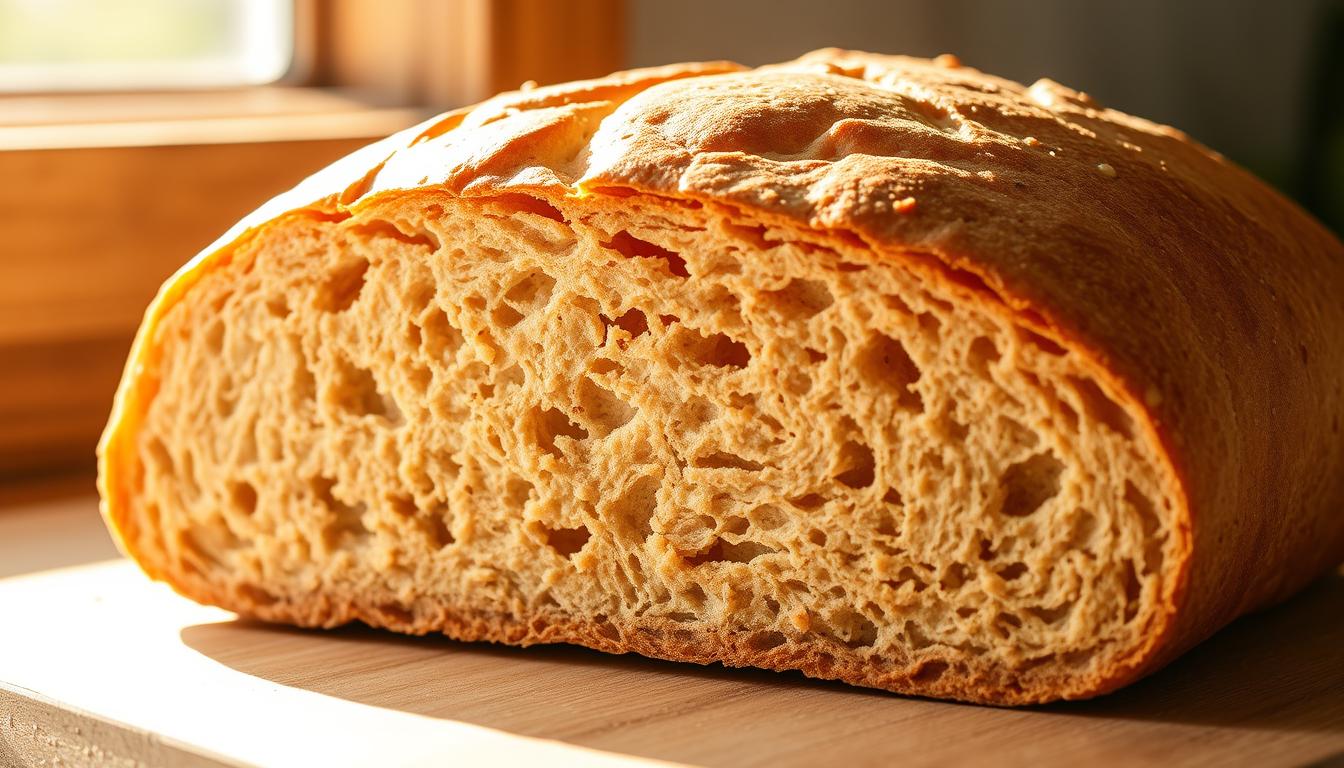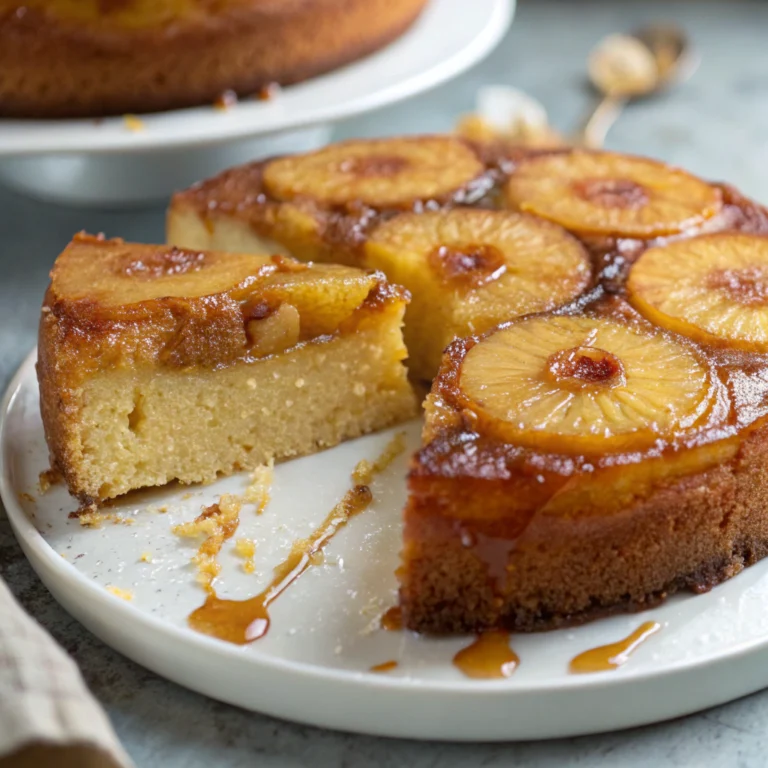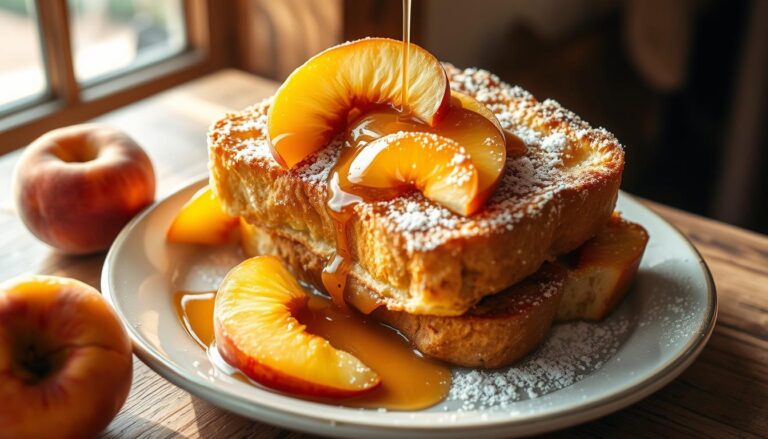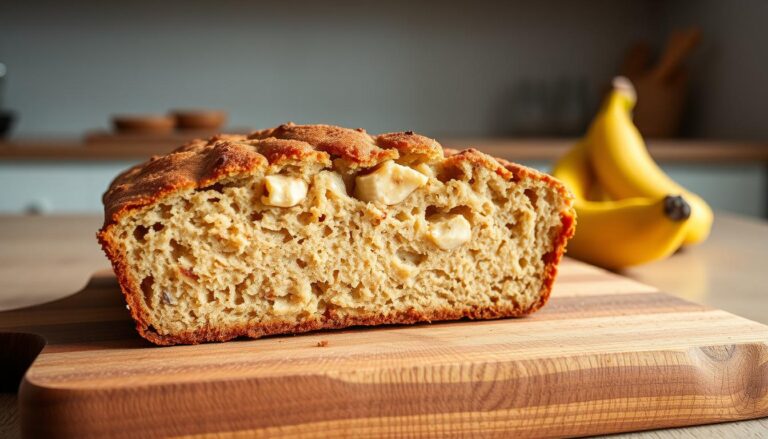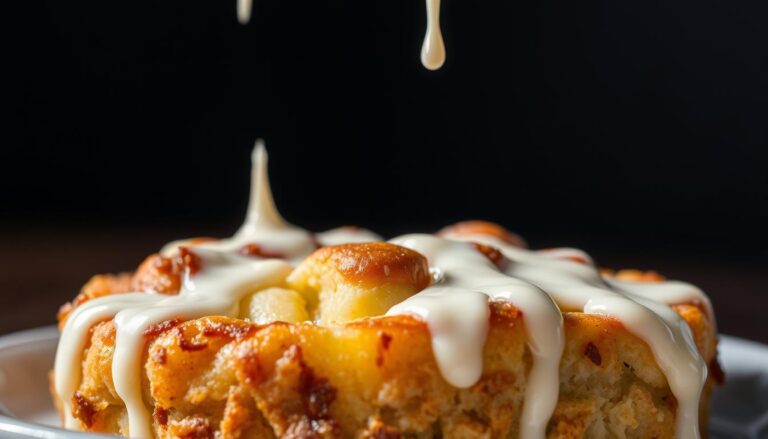Best Easy Whole Wheat Bread Recipe for a Healthy Lifestyle
Are you looking for a simple way to make healthy bread at home? With the rising concern about store-bought bread ingredients, making your own whole wheat bread is a game-changer. It’s healthier and surprisingly easy.
Imagine baking your own delicious loaf, packed with whole grains. You’ll know exactly what’s in it. This easy whole wheat bread recipe needs just a few ingredients. It’s perfect for beginners and you’ll enjoy your healthy bread soon.
By baking your own bread, you avoid preservatives and additives in commercial bread. This recipe is a great start. With a few simple steps, you’ll enjoy a healthy and delicious loaf.
The Benefits of Homemade Whole Wheat Bread
Making homemade whole wheat bread offers many benefits. You get to choose what goes into it, making it healthier. You can skip the preservatives and additives found in store-bought bread.
Nutritional Advantages Over Store-Bought Bread
Homemade whole wheat bread is packed with nutrients and fiber. It’s a better choice than store-bought bread. By picking your ingredients, you avoid additives, making it a nutritious choice for you and your family.
The benefits of whole wheat bread are well-known. Baking it yourself lets you enjoy these benefits fully.
Cost Savings of Baking Your Own Bread
Making your own whole wheat bread can be cost-effective. While the upfront expense of ingredients may appear high, the cost per loaf decreases the more you bake.
Buying ingredients in bulk and avoiding commercial bread markups also helps. Plus, you can make several loaves from one batch of dough. This makes baking your own bread a cost-effective choice in the long run.
Essential Ingredients for Perfect Whole Wheat Bread
To make perfect whole wheat bread, you need to know the key ingredients. The quality of your bread depends on the ingredients you choose. Knowing their roles helps you customize your recipe.
Understanding Different Types of Whole Wheat Flour
Whole wheat flour is the base of your bread. There are different types, like hard red wheat, hard white wheat, and soft wheat. Each flour variety has unique qualities that suit different bread recipes. Selecting the right flour is essential to achieve the perfect texture and flavor.
The Role of Each Ingredient
Each ingredient in whole wheat bread has a specific role. Knowing these roles helps you make smart choices when substituting or adjusting ingredients.
Yeast: The Rising Agent
Yeast makes the dough rise, giving bread its light and airy texture. You can use active dry yeast or instant yeast, depending on your preference.
Sweeteners and Fats
Sweeteners like sugar or honey feed the yeast. Fats such as butter or oil add flavor and tenderness to the bread.
Salt and Other Flavor Enhancers
Salt enhances the flavor of the bread and controls yeast growth. Other flavor enhancers include herbs, spices, or nuts.
Water and Liquids
Water hydrates the dough, helping the ingredients come together. Liquids like milk or eggs can add richness and complexity to the bread.
Ingredient Substitutions and Alternatives
Knowing the alternatives to each ingredient lets you customize your bread recipe. For example, you can substitute whole wheat flour with other whole grain flours. You can also adjust the type of sweetener or fat used. This helps you create a bread that fits your taste preferences and dietary needs.
Equipment You’ll Need for Baking Success
Before you start mixing and kneading, you need the right tools. Baking whole wheat bread requires some basic equipment. This makes the process easier and more fun.
Basic Tools Every Bread Baker Should Have
To begin, you’ll need a few key tools. These include:
- A large mixing bowl to hold your ingredients
- Measuring cups and spoons for accurate measurements
- A loaf pan to shape your bread
- A wooden spoon or dough whisk for mixing
These basic baking tools are key for preparing and shaping your whole wheat bread.
Optional Equipment to Enhance Your Baking
While the basic tools are a good start, some optional baking equipment can improve your baking. Consider getting:
- A stand mixer with a dough hook attachment for easier kneading
- A bread stone or baking steel for a crispy crust
- A dough scraper for handling sticky dough
These tools can help you get a more professional result. They also make the bread baking process more efficient.
Preparing Your Kitchen for Bread Making
Getting your kitchen ready for bread making is key. You need a space that helps your dough rise and keeps things organized. This makes your bread-making journey smoother.
Creating the Ideal Environment for Dough Rising
A warm, draft-free spot is essential for dough to rise. Try using the oven light or a proofing box. This warmth is what makes your bread light and fluffy.
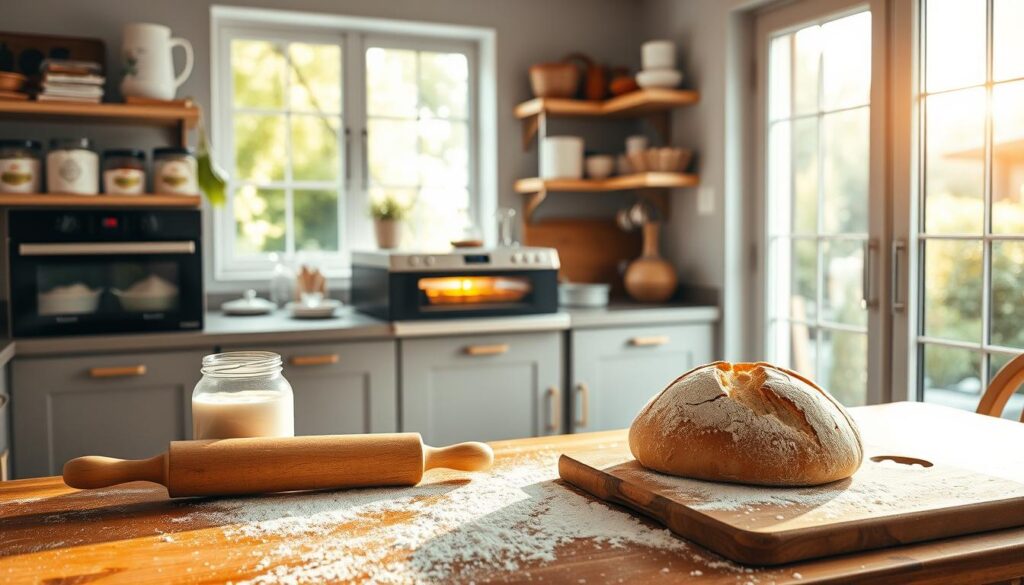
Organizing Your Workspace for Efficiency
Keeping your workspace tidy is important too. Have all your ingredients and tools close by. This saves time and makes mixing easier.
With a well-prepared kitchen, bread making becomes more fun. You can enjoy the process and make delicious homemade bread.
Complete Whole Wheat Bread Recipe Step-by-Step
We’ll show you how to bake a healthy whole wheat bread at home. It’s easy and fun. You’ll mix, knead, let it rise twice, shape, and bake it to perfection.
Mixing and Kneading the Dough
Start by mixing the ingredients together. Then, knead the dough by hand or with a machine. Proper kneading is key for the bread’s texture.
Hand Kneading Technique
Place the dough on a floured surface. Push down with your heel, fold it back, and repeat. Do this for 10 minutes until it’s smooth and elastic.
Machine Kneading Options
Use a stand mixer or a bread machine for kneading. It will knead for 5-7 minutes, depending on the machine.
First Rise: Patience is Key
Put the dough in a greased bowl, cover it, and let it rise in a warm place. It’s ready when it doubles in size, which takes about an hour.
Shaping Your Loaf
Punch down the dough to release air. Shape it into a loaf and put it in a greased loaf pan. Shaping is important for texture and look.
Second Rise and Baking Instructions
Cover the loaf pan and let it rise again until it’s just above the pan. Bake at 375°F (190°C) for 35-40 minutes. It should be golden and sound hollow when tapped.
By following these steps, you can make a delicious whole wheat bread at home. Enjoy the process and the delicious result!
Expert Tips for the Perfect Whole Wheat Bread Loaf
Want to make your whole wheat bread better? Follow expert advice to get the perfect loaf. Learn how to get the right texture and crumb. Also, find out how to fix common problems and use pro techniques.
Achieving the Ideal Texture and Crumb
To get the perfect texture and crumb, it’s all about balancing the ingredients and controlling the proofing time. Choose the right whole wheat flour and make sure the dough is well-hydrated. This will make a big difference in your bread.
Troubleshooting Common Bread Problems
Even the best bakers face problems. Here are some common issues and how to fix them:
Dense or Heavy Loaves
Too much flour or overmixing can make loaves dense. Try using less flour or mixing just until combined.
Bread Not Rising Properly
Make sure your yeast is fresh and your dough is in a warm, draft-free spot. Proper yeast activation is key for rising.
Crust Issues
Adjust your baking time and temperature to fix crust problems. Experiment to find the right balance.
Uneven Baking
Preheat your oven well and use a baking stone for even heat.
Professional Techniques for Home Bakers
Professional bakers use tricks like autolyse to improve flavor and texture. Try these methods to take your bread to the next level.
With these expert tips, you’ll soon be baking delicious, professional-quality whole wheat bread at home.
Delicious Variations of Your Basic Whole Wheat Bread
Now that you know how to make basic whole wheat bread, it’s time to try new things. Baking your own bread lets you mix and match ingredients. This way, you can make loaves that taste just right for you.
Adding Seeds, Nuts, and Grains
Make your whole wheat bread even better by adding seeds, nuts, and grains. Sunflower seeds and pumpkin seeds give a nice crunch. Walnuts and almonds add a nutty taste. You can also add quinoa, oats, or barley for more nutrition.
Here are some tasty combinations:
- Whole wheat with sunflower seeds and oats
- Whole wheat with walnuts and honey
- Multi-grain with pumpkin seeds and flaxseeds
Sweet and Savory Flavor Additions
Turn your whole wheat bread into a sweet treat with dried cranberries, cherries, or dark chocolate chips. For something savory, add herbs like rosemary or thyme. Or, mix in garlic and cheese for extra flavor.
Multi-Grain and Specialty Loaves
Try mixing different flours to make multi-grain loaves. Whole wheat with rye, spelt, or kamut creates interesting flavors. You can also make special loaves with sesame seeds for a Middle Eastern taste or Italian herbs for a Mediterranean flavor.
Storing and Preserving Your Homemade Bread
Enjoying your homemade bread for longer depends on how you store it. The right storage methods can keep your bread fresh for days or even weeks. This is true whether you eat it soon or save it for later.
Keeping Your Bread Fresh Longer
To keep your homemade whole wheat bread fresh, store it in a cool, dry place. Don’t store bread in humid areas or where sunlight hits it directly. This can make it stale or grow mold. Using a bread box or paper bag helps keep it fresh.
It’s key to keep the bread away from drafts to stop it from drying out.
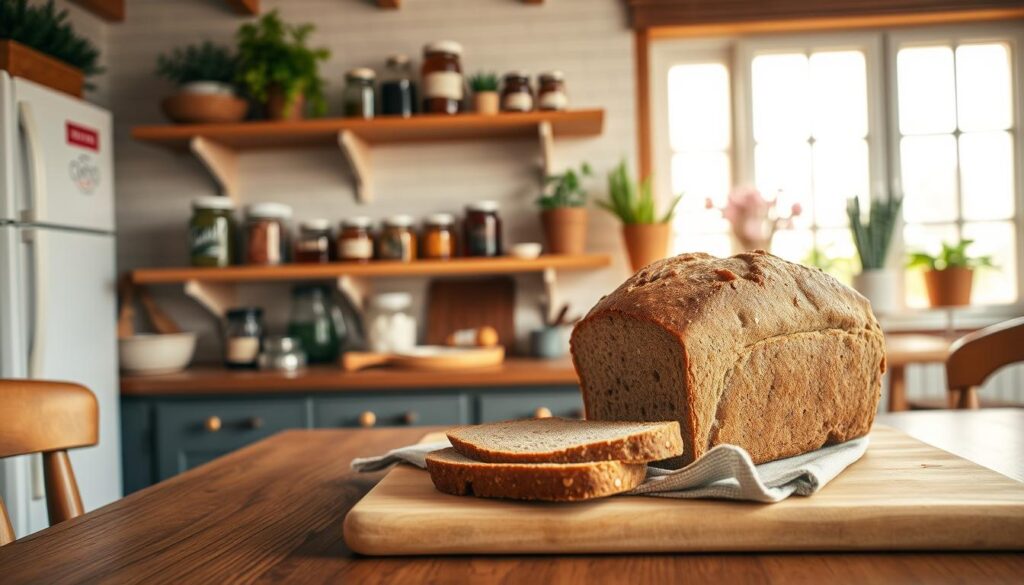
Freezing and Thawing Methods
Freezing is a great way to keep your homemade bread fresh for a long time. Wrap your cooled loaf in plastic wrap or foil and put it in a freezer-safe bag. When you want to eat it, thaw it at room temperature or reheat it in the oven.
This method keeps the bread’s moisture and flavor. For the best taste, freeze the bread within a day or two after baking.
Health Benefits of Whole Grain Bread in Your Diet
Adding whole grain bread to your meals can greatly improve your health. It’s full of fiber, vitamins, and minerals. This makes it a better choice than white flour bread.
Whole Wheat vs. White Flour: The Nutritional Difference
Whole wheat and white flour differ a lot in what they offer. Whole wheat keeps the bran, germ, and endosperm, giving you more fiber and nutrients. White flour, on the other hand, loses these parts, leaving mostly empty calories.
How Whole Grains Support Your Wellness Goals
Whole grains are key to reaching your wellness goals. They’re full of nutrients that help your body in many ways.
Fiber Content and Digestive Health
Whole grain bread’s high fiber content helps keep your bowels regular. It prevents constipation and supports a healthy digestive system.
Vitamins and Minerals in Whole Wheat
Whole wheat is rich in vitamins and minerals like selenium, potassium, and manganese. These are vital for your overall health.
Blood Sugar Management
The fiber in whole grain bread also helps control blood sugar. It slows down sugar absorption, which is good for people with diabetes or those watching their blood sugar.
By eating whole grain bread, you can enjoy these health benefits. It supports your wellness goals.
Conclusion
Baking whole wheat bread at home is easy and rewarding. It’s great for your health and saves money. You now have the basics to make tasty and healthy loaves.
As you bake more, you’ll love trying new things. You can add seeds, nuts, or sweet and savory flavors. The tips from this article will help you make the perfect loaf.
Whether you’re new to baking or have experience, making whole wheat bread is a fun journey. So, start baking and share your fresh loaves with loved ones. Enjoy the benefits of baking your own whole wheat bread.

